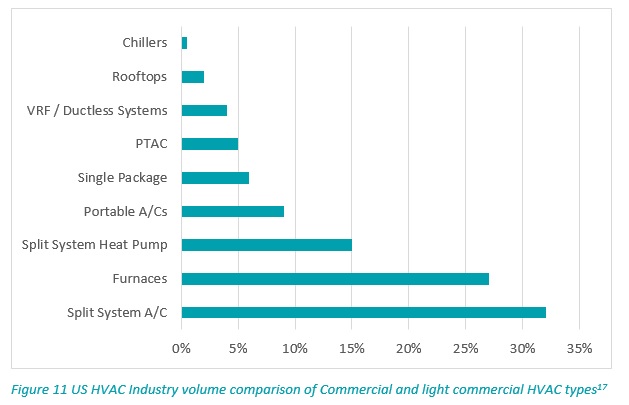
By Giselle Procaccianti | Tue, August 13, 19
There is no denying that the impacts of global warming have created a sense of urgency to accelerate decarbonization efforts in all sectors – from transport and electricity generation to building and industry.
Now more than ever, the implementation of electrification initiatives plays a critical role in reducing greenhouse gas (GHG) emissions. Specifically, electrification is critical, as the electrification process has great potential to increase energy savings through the deployment of high efficiency, electricity based technologies. One such technology is variable refrigerant flow (VRF), also known as the commercially applied air source heat pump (ASHP) technology. It provides efficient heating and cooling to commercial buildings and multi-family homes, and comes with the added benefit of improving building occupant comfort.

NEEP’s ASHP journey began in 2013 when we launched a regional market transformation initiative to accelerate the market adoption of this technology. The initiative collectively developed the Northeast/Mid-Atlantic ASHP Market Transformation Strategies Report to provide a “roadmap” of coordinated regional activities to effectively transform the market. In 2016, NEEP then produced an updated ASHP Strategy Report which presented new market strategies that, if implemented by regional stakeholders, would result in the accelerated adoption of residential ASHPs in the Northeast and Mid-Atlantic region. In October 2018, NEEP kicked of a new initiative with a focus on the commercial application of ASHP technology, specifically VRF. This involved a multi-stage process for engaging and soliciting input from VRF stakeholders to best identify and prioritize market barriers and opportunities for VRF growth in the region. The results were captured in NEEP’s forthcoming 2019 VRF Market Strategies Report.
This report identifies seven critical strategies that are necessary for VRF market transformation. Like the 2016 NEEP ASHP report, the highlighted recommendations are framed for the broader community of regional stakeholders; and sub-strategies are identified for implementation by specific stakeholders. Below you will find a snapshot of the report’s strategies, but I recommend reading the full report for a more in-depth understanding of how these strategies can be implemented throughout the region.
List of Regional Market Transformation Strategies
- Increase reporting of VRF performance and costs to improve models for predicting cost-effectiveness, energy, and GHG savings.
- Regional energy efficiency program administrators should introduce reporting requirements to capture project-specific details on system design, upfront and operational costs, and estimated or modeled savings.
- Regional VRF working group and manufacturers should collaborate to assess the opportunity for leveraging existing or additional on-board metering of VRF systems to inform field-verified performance.
- Regional stakeholders should collaborate to develop best practices for VRF building energy modeling and share updates to VRF performance curves (e.g. cold-climate models), field verified building models, and system costs.
- Support improved test procedures and performance criteria/standards to enable the promotion of climate-appropriate VRF systems.
- NEEP VRF working group should monitor and support development of national test procedures, standards, and advanced specifications that improve the correlation and accuracy to real-world and climate-specific applications.
- Develop a comprehensive regional strategy for addressing the climate and safety risks of refrigerants in VRF systems.
- NEEP VRF working group should initiate and collaborate on research aimed at identifying current VRF leakage rates, and establish data-informed best practices for VRF installations and servicing.
- NEEP VRF working group should invest in early support for industry evaluation of new refrigerants for VRF installations.
- Efficiency program administrators, state building code officials, and industry stakeholders should collaborate to support training on best practices for VRF design to mitigate safety and reduce refrigerant charge to address leak risks.
- Increase state policy support and program valuation of all energy savings and non-energy benefits of VRF technology.
- Regional state policy and efficiency programs should address policy barriers to the full valuation of VRF in reducing fossil fuel use through beneficial electrification and peak demand reduction.
- Increase HVAC workforce development and training on proper VRF design, installation, and maintenance.
- Regional stakeholders, including manufacturers and program administrators, should increase the level of investment in HVAC workforce development and training to ensure that a sufficient number of “clean energy contractors” are trained in design, installation, and maintenance best practices of new electrification technologies like VRF.
- In tandem to workforce development and training, program administrators should require manufacturer certification in the installation of VRF to increase confidence in system performance and reduce risk of refrigerant leaks.
- Reduce incremental costs and increased VRF market transformation through robust, streamlined, and aligned regional, state, and efficiency program market promotional actions.
- Regional VRF working group members should better track and report VRF costs (incremental, installed, and avoided), as well as assess the level of incentive necessary to drive sustainable, yet accelerated growth in the VRF market.
- Energy efficiency and renewable heating and cooling programs should evaluate opportunities to align program delivery strategies
- Regional VRF working group members should work to develop a multi-year market transformation strategy for increased voluntary building and equipment efficiency standards, and for education of building professionals to support VRF adoption and accelerated transition to low carbon state building energy codes.
- Promote integration of existing building management systems and advanced VRF controls to increase coordination and efficiency between building heating and cooling systems and other occupancy type controls.
- Regional VRF working group members should invest in increased building operation training, best practices in system design, and assessing program or state building code strategies to increase integration of VRF control and building energy management systems.
As the electrification revolution continues, NEEP has no intentions of slowing down. There is no denying that the benefits of VRF systems are endless, so we will continue to work with the Northeast and Mid-Atlantic region to make our recommended strategies for advancing VRF systems actionable. Later this year we plan to develop regional VRF specification and to reconvene our Northeast VRF working group to help move forward our recommended strategies.
